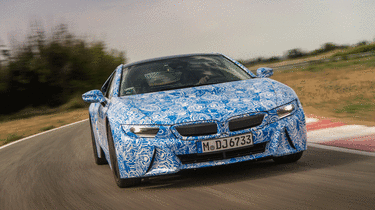BMW i8 prototype
Can a green vehicle be truly desirable as a supercar? BMW believes so – and says the mid-engined i8 hybrid proves it

The i8 is stunning to drive by any standards, not just in the world of green cars, and has dramatic looks to match. It should also prove practical every day, with a 300-mile-plus range. In fact, the price is the only issue at the moment. However, we think it could turn out to be one of the most dynamically capable BMWs ever, and a truly alternative 21st century sports car.
The new BMW i8 is pushing BMW's green 'i' brand to new levels, even though the BMW i3 city car has only just been revealed.
This mid-engined plug-in hybrid i8 supercar promises to combine the fine handling buyers expect from a BMW in a super-efficient package with zero emissions when running on electric power. But does the i8 deliver? Auto Express went to the Miramas test facility in France to drive a pre-production version.
• BMW i8 price and release date
The i8 uses the same advanced production processes as the i3, stripping weight out of the car wherever possible, with a main body carbon fibre 'Life' module. The target weight for the finished model will be less than 1,490kg, with near-perfect 50:50 weight distribution, and it promises an impressive 0.26 drag coefficient.
Used - available now

2023 Audi
Q4 Sportback e-tron
54,526 milesAutomaticElectric
Cash £23,363
2022 Kia
Niro
18,315 milesAutomaticPetrol1.6L
Cash £17,900
2023 Nissan
Juke
40,858 milesManualPetrol1.0L
Cash £12,287
2022 Volkswagen
T-Roc
36,779 milesAutomaticPetrol1.5L
Cash £18,600Yet the long, wide and low i8 has real presence on the road – that’s obvious even in our heavily disguised prototype – with some unique design flourishes, such as the ‘Rear Aero Layers’ either side of the rear screen and the hidden ‘Air Curtain’ ducts in the one-piece front bumper.
Under the skin, the i8 combines an electric motor with a 1.5-litre turbocharged three-cylinder petrol engine – developed from the company’s 3.0-litre straight-six. This powertrain allows it to be driven purely in electric mode, giving a range of 22 miles, although most of the time the two motors work together, with the electric motor driving the front wheels and the petrol engine driving the rears. A control system similar to the xDrive set-up found on BMW 4x4s manages the available grip from all wheels to ensure the i8 is well balanced.
Our pre-production i8 will benefit from further chassis development before the car goes on sale early in 2014, but it’s already dynamically accomplished. The steering is light and artificial, yet is pin-sharp and remains consistent in its responses. The electric motor provides maximum torque from zero revs, while the charismatic petrol engine pushes from the back, making the i8 extremely fast – we easily hit 110mph on a short straight at Miramas.
It also plays a key role in the impressive cornering ability. Roll is minimal and understeer is only evident with heavy-handed turn-in – the chassis is capable, very entertaining and pretty much spot-on as it is. With a bit more fine-tuning, it should be astonishing.
When not being driven so hard, the i8 has a supple ride, while the drivetrain switches seamlessly between electric and hybrid running. The petrol engine and the brakes charge the lithium-ion battery when not under full load, and BMW assures us that there will be “no situation in road driving where the battery charge is exhausted, leaving you with only petrol power”.
Charging infrastructure is not so key to the i8’s success as it is to the i3’s, as the battery can be revived within three hours using a standard wall socket (less than two hours using a BMW i Wallbox). But while prices have yet to be finalised, a senior BMW figure admitted the i8 will cost in excess of 100,000 Euros (about £86,000) when it goes on sale in 2014.
Whether people will be willing to pay that for a three-cylinder car remains to be seen – but ignore the capacity, and a 357bhp mid-engined BMW can only be a good thing. Even on this early showing, the i8 promises to be a brilliant driver’s car.








